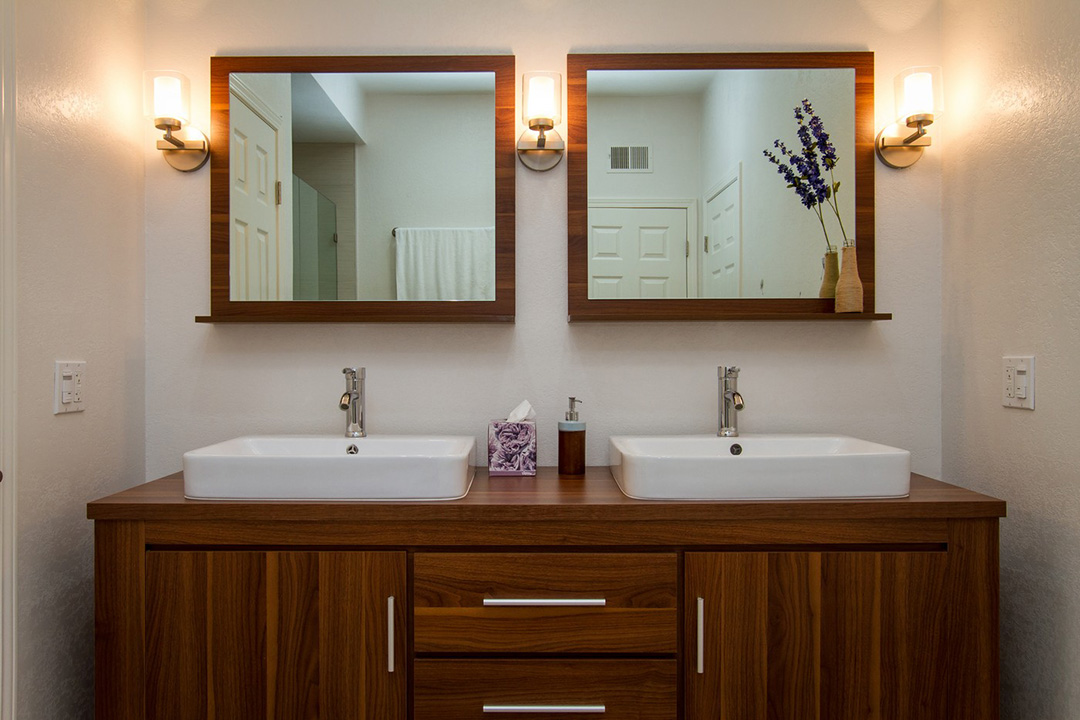Bathroom vanities are the hardest working cabinetry in your home. They have to hold up to daily wear and tear as you get ready for work or give kids their baths. And they’re constantly exposed to moisture, which is no friend to wood or wood-like materials.
Also, bathroom space usually is at a premium, so the size and location of cabinets is doubly important. A wider vanity will give you more storage, while a narrower vanity will give you more room to move around.
So many choices and decisions. Here’s a guide to selecting and placing vanity cabinets.
Fitting Vanities and Cabinets to Your Budget
You can find bathroom vanities and cabinets for any budget and style, although the lower your budget, the more limited your style choices.
Budget ($70 to $150 per linear foot): Stock cabinets are mass-produced and afford no customization. But you save money and time by buying stock.
They start at 9 inches wide and go up in 3-inch increments to 60 inches wide and come in 12-inch or 24-inch depths.
I bought a stock vanity when I added a basement bathroom recently, and I love it. You can pluck a 30-inch-wide vanity right from the shelf, no waiting time, for $150 to $500.
Better ($450 to $540 per linear foot): Semi-custom gives you more choice of size and style. You can change widths in 1-inch intervals, and depths according to manufacturer guidelines. You’ll have more choices in door styles, stains, and glazes, though not as much as in custom cabinets. Figure on waiting around three weeks for delivery.
Best ($1,200 to $1,400 per linear foot): Custom cabinets let you achieve your dream cabinet with any size, design, or color. Want a high cabinet (36-inch to 42-inch) for more storage and to reduce stooping to brush your teeth? Custom can give you that. Want beading around doors? No problem. But that customization comes at a cost in money and waiting time — six to eight weeks.
Cabinet Construction: The Key to Quality
Bathroom cabinets must stand up to moisture and a lot of opening and closing. So construction of the box — the bones of the cabinet — is important.
Budget: You’ll get 1/2-inch particleboard sides; stapled, nailed, or glued drawers; and partial-opening drawer slides. This construction works best for powder room vanities, which don’t see as much wear and tear. But the moisture in full baths will eventually weaken the particleboard (it’s only made of pressed sawdust) and make it sag. Stock cabinet drawers don’t have lasting power.
Better: Now we’re talking 1/2-inch plywood boxes — way sturdier than particleboard — and dovetailed drawers, which hold up better than stapled or glued drawers.
Best: Top-of-the-line construction includes 1/2-inch to 3/4-inch plywood or hardwood sides, and 5/8-inch hardwood drawers with dovetail or dowel joints. You can get full-extension drawer glides, which make it easier to see what’s in the back of drawers, and soft-close glides that eliminate banging.
Tips for Choosing Bath Vanities
- Ornate cabinets with beading are lovely, but may not be practical in bathrooms. Water from shower steam collects in beading, and you’ll have to towel them off to prevent droplets from eating away at finishes. If you do go for doodads, make sure the cabinets are sealed well.
- Unless you love mopping floors, buy base cabinets that rest on the floor, rather than on wood feet. Feet give cabinets the look of furniture, but cleaning under those cabinets is a constant chore.
- If a local craftsman builds your custom cabinets, make sure the cabinets are sealed well. If not, they won’t stand up to bathroom moisture.
- Make sure your bathroom fan is in tip-top shape to prevent the room from getting too steamy and penetrating wood cabinets.
- If you need maximum counter space, pick a vanity with an off-center sink.
Related: 20 Small Bathroom Ideas that Save Time and Money
Vanity Location is Vital
Once you’ve decided what type of bathroom vanity you want and can afford, you have to decide where to put it — not as easy as it sounds because every square inch of bathroom space counts.
- Make sure cabinet doors have enough room to swing without hitting something or getting in the way of foot traffic. Measure the depth of vanities with doors open to make sure they fit comfortably. Building codes say the minimum allowable distance in front of vanities (and toilets) is 21 inches.
- Be sure there’s enough space over and around the vanity to install a mirror and lights. Side sconces are best for eliminating face shadows. If that’s important to you, make sure you have enough room on each side of the mirror to place lights.
- Take advantage of existing plumbing. Hooking up a new vanity to old plumbing is easy and inexpensive. But moving plumbing up, down, or across the room can cost you big bucks, considering you’ll pay a plumber typically from $45 to $65 per hour for labor alone. Of course, everything is a tradeoff. Just make sure you’ve got a darn good reason for moving plumbing around.
- Place your vanity on or near a wall that can accommodate a wall-mounted or recessed medicine cabinet or shelving, because it’s a pain to walk across the bathroom whenever you want a Q-tip. Medicine cabinets start at around $15.
